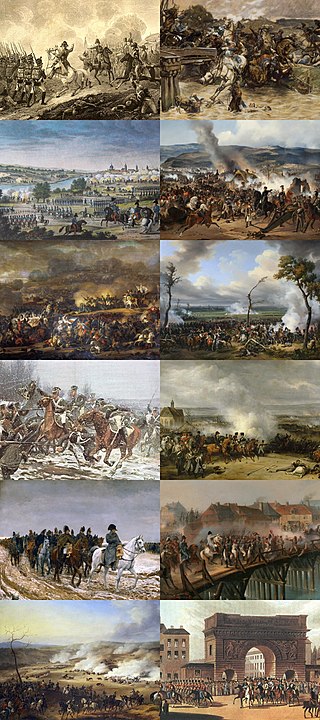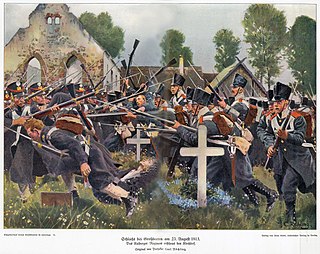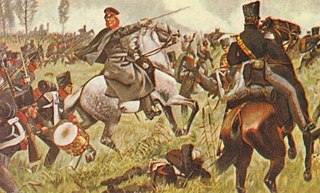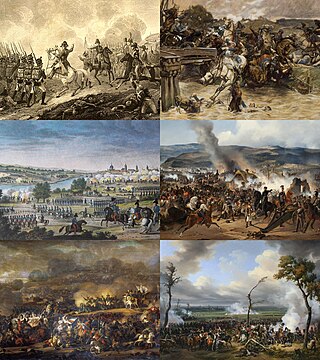
The Battle of Leipzig, also known as the Battle of the Nations, was fought from 16 to 19 October 1813 at Leipzig, Saxony. The Coalition armies of Austria, Prussia, Sweden, and Russia, led by Tsar Alexander I and Karl von Schwarzenberg, decisively defeated the Grande Armée of French Emperor Napoleon Bonaparte. Napoleon's army also contained Polish and Italian troops, as well as Germans from the Confederation of the Rhine. The battle was the culmination of the German Campaign of 1813 and involved 560,000 soldiers, 2,200 artillery pieces, the expenditure of 400,000 rounds of artillery ammunition, and 133,000 casualties, making it the largest battle of the Napoleonic Wars, and the largest battle in Europe prior to World War I.

The Battle of Dresden was a major engagement of the Napoleonic Wars. The battle took place around the city of Dresden in modern-day Germany. With the recent addition of Austria, the Sixth Coalition felt emboldened in their quest to expel the French from Central Europe. Despite being heavily outnumbered, French forces under Napoleon scored a victory against the Army of Bohemia led by Generalissimo Karl von Schwarzenberg. However, Napoleon's victory did not lead to the collapse of the coalition, and the weather and the uncommitted Russian reserves who formed an effective rear-guard precluded a major pursuit. Three days after the battle, the Allies surrounded and destroyed a French corps advancing into their line of withdrawal at the Battle of Kulm.

The Battle of Montmirail was fought between a French force led by Emperor Napoleon and two Allied corps commanded by Fabian Wilhelm von Osten-Sacken and Ludwig Yorck von Wartenburg. In hard fighting that lasted until evening, French troops including the Imperial Guard defeated Sacken's Russian soldiers and compelled them to retreat to the north. Part of Yorck's Prussian I Corps tried to intervene in the struggle but it was also driven off. The battle occurred near Montmirail, France, during the Six Days Campaign of the Napoleonic Wars. Montmirail is located 51 kilometres (32 mi) east of Meaux.

In the War of the Sixth Coalition, sometimes known in Germany as the Wars of Liberation, a coalition of Austria, Prussia, Russia, Spain, Great Britain, Portugal, Sweden, Sardinia, and a number of German States defeated France and drove Napoleon into exile on Elba. After the disastrous French invasion of Russia of 1812 in which they had been forced to support France, Prussia and Austria joined Russia, the United Kingdom, Sweden, and Portugal, and the rebels in Spain who were already at war with France.

Friedrich Wilhelm Freiherr von Bülow, Graf von Dennewitz was a Prussian general of the Napoleonic Wars.
Dennewitz is a village of Germany, in the federal state and old Prussian province of Brandenburg, near Jüterbog, 40 km. S.W. from Berlin. It is part of the municipality of Niedergörsdorf, Teltow-Fläming district.

The Battle of Großbeeren occurred on 23 August 1813 in neighboring Blankenfelde and Sputendorf between the Prussian III Corps under Friedrich von Bülow and the Franco-Saxon VII Corps under Jean Reynier. Napoleon had hoped to drive the Prussians out of the Sixth Coalition by capturing their capital, but the swamps south of Berlin combined with rain and marshal Nicolas Oudinot's ill health all contributed to the French defeat.

The Battle of the Katzbach on 26 August 1813, was a major battle of the Napoleonic Wars between the forces of the First French Empire under Marshal MacDonald and a Russo-Prussian army of the Sixth Coalition under Prussian Marshal Graf (Count) von Blücher. It occurred during a heavy thunderstorm at the Katzbach river between Wahlstatt and Liegnitz in the Prussian province of Silesia. Taking place the same day as the Battle of Dresden, it resulted in a Coalition victory, with the French retreating to Saxony.

The Battle of Elchingen, fought on 14 October 1805, saw French forces under Michel Ney rout an Austrian corps led by Johann Sigismund Riesch. This defeat led to a large part of the Austrian army being invested in the fortress of Ulm by the army of Emperor Napoleon Bonaparte of France while other formations fled to the east. Soon afterward, the Austrians trapped in Ulm surrendered and the French mopped up most of the remaining Austrian forces, bringing the Ulm Campaign to a close.

The Battle of Wartenburg took place on 3 October 1813 between the French IV Corps commanded by General Henri Gatien Bertrand and the Allied Army of Silesia, principally the I Corps of General Ludwig von Yorck. The battle allowed the Army of Silesia to cross the Elbe, ultimately leading to the Battle of Leipzig.

The Battle of Schleiz took place on 9 October 1806 in Schleiz, Germany between a Prussian-Saxon division under Bogislav Friedrich Emanuel von Tauentzien and a part of Jean-Baptiste Bernadotte's I Corps under the command of Jean-Baptiste Drouet, Comte d'Erlon. It was the first clash of the War of the Fourth Coalition, part of the Napoleonic Wars. As Emperor Napoleon I of France's Grande Armée advanced north through the Franconian Forest it struck the left wing of the armies belonging to the Kingdom of Prussia and the Electorate of Saxony, which were deployed on a long front. Schleiz is located 30 kilometers north of Hof and 145 kilometers southwest of Dresden at the intersection of Routes 2 and 94.

The Battle of Lübeck took place on 6 November 1806 in Lübeck, Germany between soldiers of the Kingdom of Prussia led by Gebhard Leberecht von Blücher, who were retreating from defeat at the Battle of Jena–Auerstedt, and troops of the First French Empire under Marshals Murat, Bernadotte, and Soult, who were pursuing them. In this War of the Fourth Coalition action, the French inflicted a severe defeat on the Prussians, driving them from the neutral city. Lübeck is an old Baltic Sea port approximately 50 kilometres (31 mi) northeast of Hamburg.

Bogislav Friedrich Emanuel Graf Tauentzien von Wittenberg was a Prussian general of the Napoleonic Wars.

The Battle of Luckau was fought at Luckau in Brandenburg on 4 June 1813 during the War of the Sixth Coalition. Prussian and Russian forces under General Friedrich Wilhelm von Bülow defeated part of a French-Allied corps under Marshal Nicolas Oudinot.

In the Battle of Mohrungen on 25 January 1807, most of a First French Empire corps under the leadership of Marshal Jean-Baptiste Bernadotte fought a strong Russian Empire advance guard led by Major General Yevgeni Ivanovich Markov. The French pushed back the main Russian force, but a cavalry raid on the French supply train caused Bernadotte to call off his attacks. After driving off the cavalry, Bernadotte withdrew and the town was occupied by the army of General Levin August, Count von Bennigsen. The fighting took place in and around Morąg in northern Poland, which in 1807 was the East Prussian town of Mohrungen. The action was part of the War of the Fourth Coalition in the Napoleonic Wars.

The German campaign was fought in 1813. Members of the Sixth Coalition, including the German states of Austria and Prussia, plus Russia and Sweden, fought a series of battles in Germany against the French Emperor Napoleon, his marshals, and the armies of the Confederation of the Rhine - an alliance of most of the other German states - which ended the domination of the First French Empire.
The VI Corps of the Grande Armée was a French military unit that existed during the Napoleonic Wars. It was formed at the Camp de Boulogne and assigned to Marshal Michel Ney. From 1805 to 1811, the VI Corps fought under Ney's command in the 1805 Austrian Campaign: War of the Third Coalition, Prussian Campaign of 1806 and Polish Campaign of 1807 of the War of the Fourth Coalition. General Jean Gabriel Marchand was in charge of the corps for a period when Ney went on leave. The VI Corps was revived in 1812 for the French invasion of Russia and placed under Marshal Laurent Gouvion Saint-Cyr. It consisted entirely of Bavarian soldiers at that time. During the disastrous retreat from Moscow, the corps was virtually destroyed. In 1813, during the War of the Sixth Coalition, it was rebuilt and reorganized with French troops. Marshal Auguste de Marmont took command of the corps and managed it until Napoleon's abdication in 1814. It took part in many battles including Dresden and Leipzig in 1813. During the War of the Seventh Coalition, General Georges Mouton commanded the VI Corps at the Battle of Waterloo.
The III Cavalry Corps of the Grande Armée was a French military unit that existed during the Napoleonic Wars. The corps was created in 1812 and reconstituted in 1813 and 1815. Emperor Napoleon Bonaparte first mobilized the corps for the invasion of Russia. Commanded by General Emmanuel de Grouchy, two divisions of the corps fought at Borodino, Tarutino, and Vyazma. A third division fought at the First and Second battles of Polotsk and the Berezina. During the War of the Sixth Coalition in 1813, General Jean-Toussaint Arrighi de Casanova led the corps at Großbeeren, Dennewitz, Leipzig, and Hanau.
The Battle of Courtrai saw Johann von Thielmann's Kingdom of Saxony troops and a few Prussians encounter an Imperial French force under Nicolas Joseph Maison near Kortrijk (Courtrai), a city south-west of Ghent in what is now Belgium. Thielmann attacked only to find himself facing the bulk of Maison's I Corps. The action ended in a rout of the Saxons, most of whom were under fire for the first time.

The Battle of Arnhem saw Friedrich Wilhelm Freiherr von Bülow's Prussian corps fight an Imperial French division under Henri François Marie Charpentier at Arnhem. Attacking under the cover of fog, the Prussians broke into the city at several points and forced the French to retreat to Nijmegen after hard fighting in this War of the Sixth Coalition clash. Arnhem is a city in the Netherlands located on the Rhine River 100 kilometres (62 mi) southeast of Amsterdam.





















